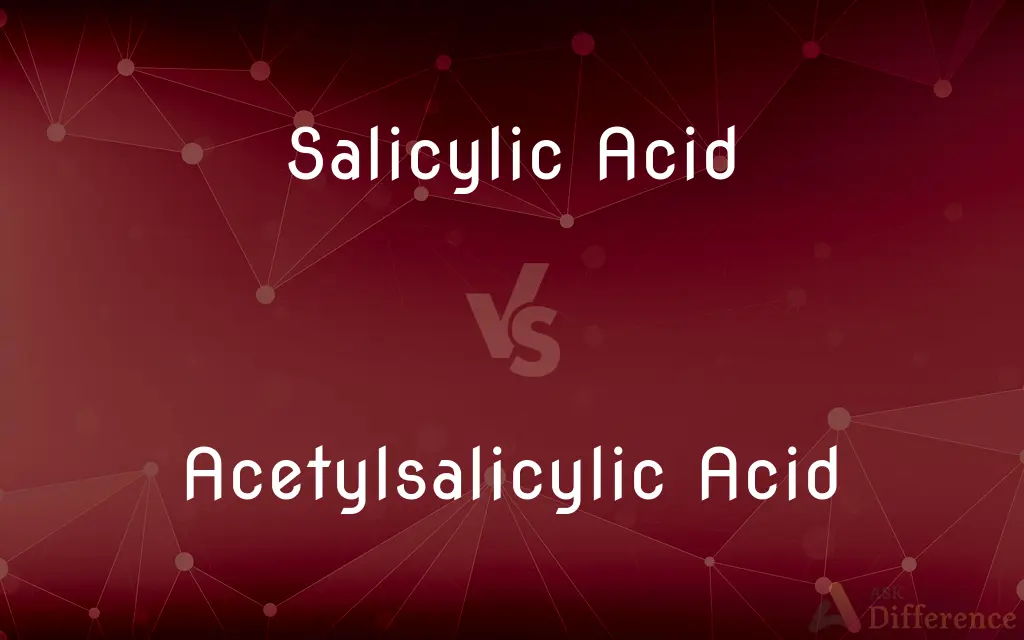Salicylic Acid vs. Acetylsalicylic Acid — What's the Difference?
By Tayyaba Rehman — Published on November 12, 2023
Salicylic Acid is a beta hydroxy acid known for skincare benefits. Acetylsalicylic Acid, also known as aspirin, is utilized for its analgesic and anti-inflammatory properties.

Difference Between Salicylic Acid and Acetylsalicylic Acid
Table of Contents
ADVERTISEMENT
Key Differences
Salicylic Acid stands prominent in the skincare arena, lauded for its ability to exfoliate the skin, clear pores, and combat acne. It's a beta hydroxy acid (BHA) that exhibits commendable exfoliating properties, facilitating the removal of dead skin cells and revealing a more radiant complexion beneath. As a topical agent, Salicylic Acid is notably present in various acne treatment products, and its propensity to unclog pores and mitigate inflammation makes it a staple in various skincare formulations.
Acetylsalicylic Acid, on the other hand, is universally recognized by its more common name, aspirin. This acid is ubiquitously utilized as a pain reliever and an anti-inflammatory agent. Acetylsalicylic Acid functions by inhibiting the production of certain natural substances that propagate pain, fever, and inflammation. Beyond its analgesic applications, it also offers antipyretic and anti-inflammatory capabilities, rendering it indispensable in alleviating symptoms like fever and reducing pain and inflammation in the body.
Both Salicylic Acid and Acetylsalicylic Acid originate from willow bark but their applications veer into disparate pathways within the realm of healthcare and wellness. Salicylic Acid, with its ability to penetrate oil-laden pores, offers specialized applications in managing skin conditions, particularly those associated with excess sebum production, acne, and overall skin clarity, ensuring a smoother, clearer skin surface when applied topically.
Conversely, Acetylsalicylic Acid is renowned for systemic applications, providing respite from various pain-related conditions, reducing fever, and potentially offering cardioprotective benefits. Its systemic anti-inflammatory and anticoagulant properties make Acetylsalicylic Acid a potent agent in managing pain, inflammation, and in mitigating the risk of certain cardiovascular events, such as heart attacks, under specific circumstances.
In essence, while both Salicylic Acid and Acetylsalicylic Acid share a common lineage and exhibit anti-inflammatory properties, their practical applications, administration routes, and consequent physiological impacts vary significantly. Salicylic Acid finds its niche in skincare, offering exfoliating and anti-acne benefits, whereas Acetylsalicylic Acid, or aspirin, is oriented towards pain relief, anti-inflammation, and potential cardiovascular benefits.
ADVERTISEMENT
Comparison Chart
Primary Application
Skincare, specifically acne treatment
Pain relief, anti-inflammatory, antipyretic
Common Formulation
Topical creams and gels
Oral tablets
Known For
Exfoliating skin
Relieving pain
Interaction with Skin
Can cause mild irritation in some people
Typically not used topically
Notable Property
Beta hydroxy acid (BHA)
Non-selective COX inhibitor
Compare with Definitions
Salicylic Acid
Might cause sensitivity in some users.
I perform a patch test with Salicylic Acid to avoid irritation.
Acetylsalicylic Acid
Can be utilized as an antipyretic.
Acetylsalicylic Acid aids in lowering fever during a cold.
Salicylic Acid
Known for exfoliating skin.
Salicylic Acid gently exfoliates to reveal brighter skin.
Acetylsalicylic Acid
Possesses anti-inflammatory properties.
Acetylsalicylic Acid helps in reducing my joint inflammation.
Salicylic Acid
Utilized in various skincare products.
My cleanser contains Salicylic Acid for clearer pores.
Acetylsalicylic Acid
May provide cardiovascular benefits.
Doctors sometimes recommend Acetylsalicylic Acid for heart health.
Salicylic Acid
Can help minimize pore appearance.
Salicylic Acid unclogs and appears to shrink my pores.
Acetylsalicylic Acid
Also known as aspirin.
Acetylsalicylic Acid effectively reduces my headache.
Salicylic Acid
An acne-fighting ingredient.
Salicylic Acid helps diminish my acne breakouts.
Acetylsalicylic Acid
Used for pain relief.
I take Acetylsalicylic Acid to alleviate muscle pain.
Common Curiosities
Can Acetylsalicylic Acid reduce fever?
Yes, it's an effective antipyretic.
Is Salicylic Acid effective for all skin types?
Most, but patch testing is recommended.
Can I find Salicylic Acid in shampoos?
Yes, it is used in certain dandruff shampoos.
Can Salicylic Acid treat acne?
Yes, it is commonly used to treat acne.
Can Acetylsalicylic Acid cause gastrointestinal issues?
Yes, it can cause stomach issues in some.
Can Salicylic Acid fade scars?
It may lighten them with continual use.
Is Salicylic Acid available over the counter?
Yes, in various skincare products.
Is Acetylsalicylic Acid the same as aspirin?
Yes, Acetylsalicylic Acid is commonly known as aspirin.
Can Salicylic Acid cause skin irritation?
Yes, it can cause irritation in some individuals.
Is Acetylsalicylic Acid safe for all age groups?
No, its use is cautioned in children with viral infections.
Can Acetylsalicylic Acid prevent heart attacks?
It may reduce risk, but consult a doctor first.
Can Salicylic Acid remove warts?
Yes, it's used in some wart-removal treatments.
Does Acetylsalicylic Acid interact with other drugs?
Yes, especially anticoagulants and NSAIDs.
Are Salicylic Acid and Acetylsalicylic Acid derived from the same source?
Yes, both can be derived from willow bark.
Can Acetylsalicylic Acid be used during pregnancy?
Typically no, especially in the third trimester.
Share Your Discovery

Previous Comparison
Apple vs. Mac
Next Comparison
GDP vs. National IncomeAuthor Spotlight
Written by
Tayyaba RehmanTayyaba Rehman is a distinguished writer, currently serving as a primary contributor to askdifference.com. As a researcher in semantics and etymology, Tayyaba's passion for the complexity of languages and their distinctions has found a perfect home on the platform. Tayyaba delves into the intricacies of language, distinguishing between commonly confused words and phrases, thereby providing clarity for readers worldwide.












































